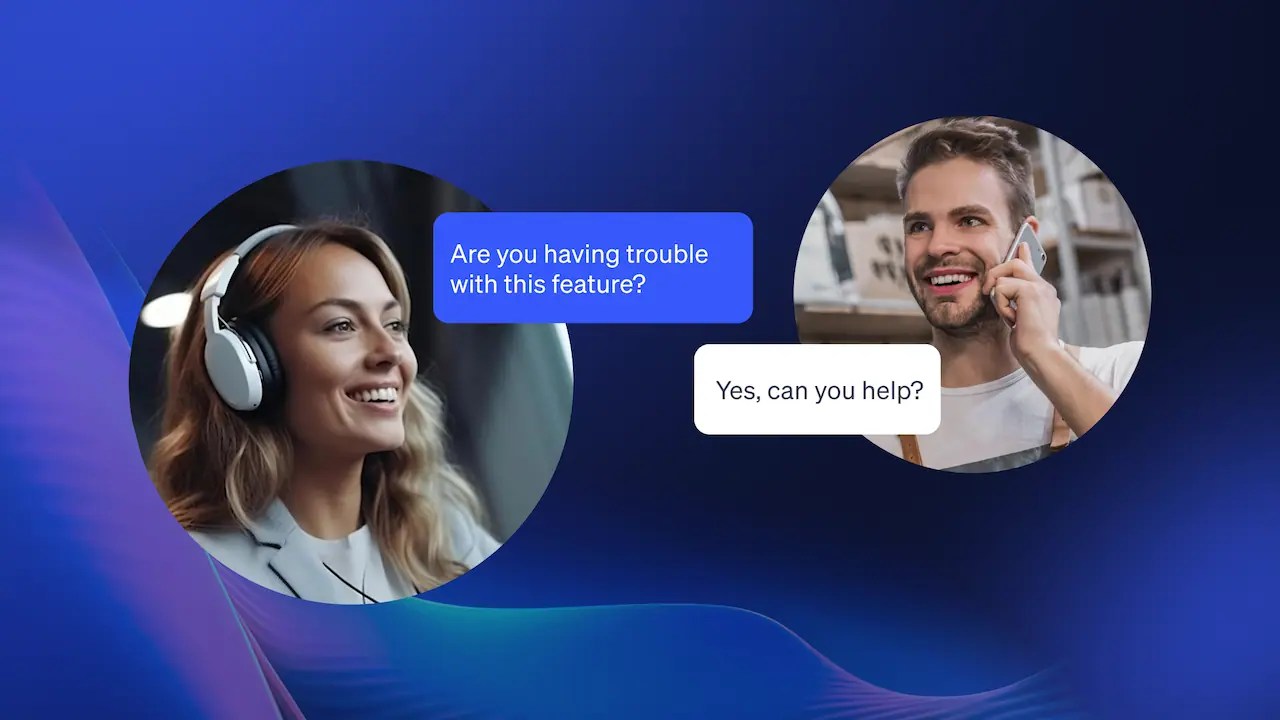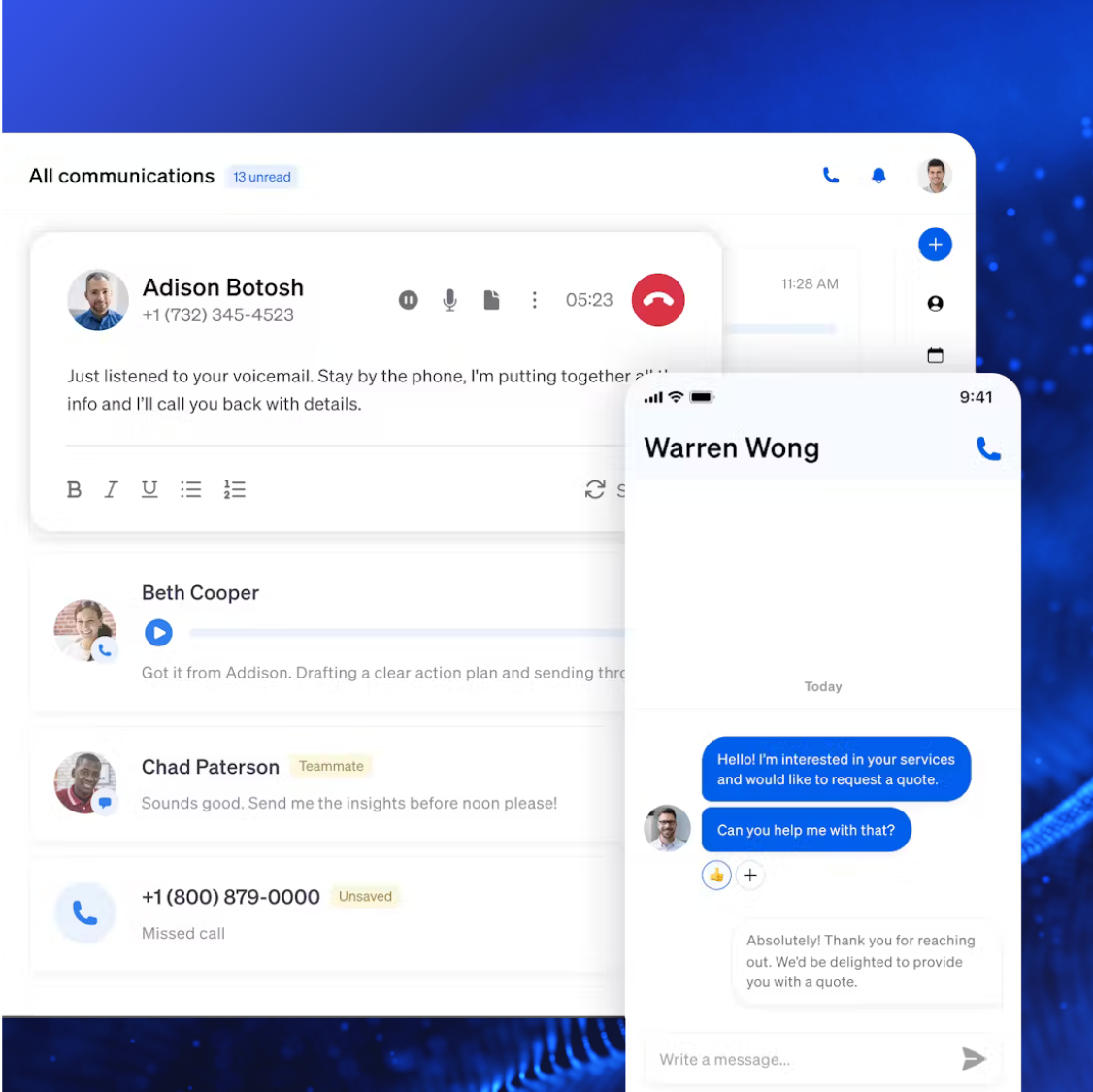Chatbots changed tremendously as generative AI and large language models emerged.
Previously, chatbots worked according to a set of rules, but with AI technology, they can now understand and respond to queries just like humans. AI models have added conversational capabilities to conventional chatbots, empowering them to interact like humans.
The conversational AI chatbots have added many benefits for businesses, including improving operations in their contact centers. There are substantial cost savings associated with fully implementing chatbots — Gartner analysts estimate over $80.0 billion in reduced contact center expenses by 2026.
Let’s discuss the fundamentals of conversational AI chatbots and consider the benefits you can expect from using them in your business.
What Are Conversational AI Chatbots?
Conversational AI chatbots are virtual agents that use AI to simulate conversations with human users. They imitate human language and interactions by using natural language processing (NLP), machine learning (ML), and training on volumes of datasets.
There are two types of Conversational AI chatbots: fully automated or semi-automatic.
A fully automated chatbot handles interactions independently without involving a live agent, as it understands questions and provides its own solutions. This allows you to automate simpler queries that don’t require the time and attention of human agents, making them more productive in handling critical issues.

A semi-automatic conversational AI platform, however, manages simple questions and answers independently. It works alongside human agents to offer better support when encountering complex issues.
Semi-automatic conversational AI solutions let you pass a complex chat to a human agent who can offer more personalized support, enhancing the customer experience.
How Do Conversational AI Chatbots Work?
In simple terms, AI chatbots work by first understanding the customer’s input, evaluating it against known rules and existing datasets and responding with the best approach for the situation. Beneath the surface, however, there are a lot of mechanics involved.
Various components of conversational AI chatbots work together to run the operations. ML improves the quality of interactions as the system becomes more experienced. The platform gradually gets better at recognizing patterns and making predictions.
NLP analyzes language to understand the input, and it works in four phases:
- Input generation: Users provide input in a text or audio format through a website or an app.
- Input analysis: The AI chatbot understands text-based input and user intent through natural language understanding (NLU), which is a component of NLP. The chatbot also examines audio input data using speech recognition and NLU.
- Dialogue management: The chatbot uses a component of NLP to choose and create the most appropriate responses.
- Reinforcement learning: The ML algorithm refines responses and improves their accuracy based on feedback.
Chatbots use NLP to understand user intent and create a response or take action based on that. Over time, chatbots learn from interactions and improve their response accuracy through ML.
Nvidia uses AI to illustrate the technical steps required to provide real-time conversational support:

In 2024, monumental leaps in AI capability and emotional understanding have improved from earlier iterations.
Benefits of Conversational AI Chatbots for Businesses
Conversational AI chatbots offer several benefits for businesses, especially in customer support. Below are some notable perks.

24/7 availability
Unlike human agents, chatbots are available 24/7 to answer customer queries and provide support irrespective of time and place.
If a query is complex, the chatbots can convey a service-level agreement, letting the user know that support is on the way. Whenever the chatbot encounters a query it cannot resolve, it can create a ticket and promise an update within two business days.
The conversational AI chatbot can resolve simpler queries in the same chat, transforming the call into a delightful experience for your customers.

Improved efficiency
Conversational AI tools pick up routine queries and free up human agents’ time, making them more efficient in solving critical issues. A chatbot can quickly resolve a query requesting to update a phone number, so you don’t need a human agent’s expertise to do that.
Human agents can then focus on more critical support issues, such as a customer being unable to log in, even with the correct username and password combination.
Customer service teams handle 20,000 support requests monthly. According to Zendesk’s research, chatbots can save more than 240 hours.
Increased lead generation
Using your website’s content, you can train conversational AI chatbots to help visitors find what they seek. When visitors engage with the chatbot, it will ask relevant questions to qualify them as leads.
If the visitors fit your buyer persona, the chatbot encourages them to book a meeting with the sales team, helping you drive more conversions from the website. This adds more leads into your sales pipeline while ensuring visitors align with the company’s ideal customer profile.

Personalized customer service
Conversational AI chatbots easily integrate with social CRM systems and customer data platforms. While interacting with a user, chatbots go through historical interactions with the user to maintain the right context for the conversation.
This personalizes the conversation, so customers don’t need to repeat information given in previous interactions, making it a better support experience.
Reduced costs
Conversational AI chatbots automate several tasks to reduce the workload of human agents, allowing them to resolve issues faster and take on more critical issues than before. Simply put, chatbots free up the time agents spend on monotonous and routine queries, reducing the costs tied to the time they invest.
“Many organizations are challenged by agent staff shortages and the need to curtail labor expenses, which can represent up to 95% of contact center costs. Conversational AI makes agents more efficient and effective while also improving the customer experience.”
~Daniel O’Connell, VP analyst at Gartner
Chatbots help you make better use of your resources without having to add more for routine and repetitive tasks in different use cases. The chatbot easily automates such tasks, helping you get a better ROI. IBM research shows that chatbot-led service interactions are 30% cheaper for businesses than agent-led conversations.
Data collection and insights
Based on user queries, a conversational AI chatbot gathers valuable insights and feedback to improve your products and services. These real-time insights are vital in creating documentation pages to answer frequently asked questions.
Marketing teams can also use these insights to improve their product or service positioning. This will prevent confusing messages from reaching your audience, helping you deliver on your promises.
Related: What You Need to Know Before You Use Chatbots for Your Website
Best Practices to Follow While Implementing Conversational AI Chatbots
When implementing a conversational AI chatbot for your business, follow the best practices below
Define the chatbot’s purpose
To be effective, a chatbot needs a clear purpose. You should clearly define the tasks it needs to handle and the ones it should hand over to its human counterparts. Make a list.
You’ll likely encounter scenarios where chatbots don’t meet users’ needs. In such cases, ensure handovers happen seamlessly, and the user doesn’t feel any unnecessary friction when switching between conversing with a chatbot and a human.
Train them on a comprehensive knowledge base
A conversational AI chatbot must be well-informed about your business. Giving it access to your comprehensive knowledge base will help keep your information up to date. You should regularly update this knowledge base whenever product changes, policy updates, or service modifications occur.
Identify the most common queries your team gets and ensure the chatbot has the required knowledge to solve them. If customers frequently inquire about your return policy, the chatbot should respond clearly about return timelines and associated costs.
Prioritize user experiences
Ensure that conversations feel natural, engaging, and, most importantly, easy to follow. Keep the chatbot’s tone friendly as it conveys information to users, encouraging them to return as it builds more trust and increases customer engagement.
Use the prospect’s or customer’s name in interactions and add personal touches to make them appear more human. Avoid technical jargon or overly complicated language. Configure the chatbot to keep interactions straightforward and to respond with direct answers without beating around the bush.
Suppose a chatbot doesn’t understand a question. Program it to ask for clarification rather than respond with a generic apology message or repeatedly say, “I didn’t catch that.”
Be transparent about limitations
Let users know what the chatbot can and cannot do. Don’t confuse the customer or prospect if the chatbot cannot process payments. Simply guide them to the appropriate channels for the tasks a chatbot cannot perform.
This helps you win your audience’s trust and reduce frustration. If a question is too complicated for the chatbot, it should offer the alternative of connecting to a human agent who can provide more information from a separate page or article.
When interacting with a prospect or customer, the chatbot should set the expectation by saying, “I’m here to help with common questions about our services and products.”
Continuously improve based on feedback
Deeply research which questions the chatbot provides unsatisfactory answers for. Train the chatbot to improve its understanding of such queries. Conduct research regularly to spot patterns and issues in a chatbot’s interactions, and let it improve and learn from the feedback it receives from customers or prospects.
Continuous improvement keeps your chatbot relevant and effective in addressing customers’ queries.
Related: Top Chatbot Providers: Key Features, Uses, & Campaign Ideas
Why Integrate Conversational AI Chatbots With Your Contact Center?
Contact centers can take advantage of conversational AI-powered chatbots in several ways. Below are some common benefits you can expect.
Streamlined workflows
Integrating chatbot interactions with agent consoles gives a unified view of a customer’s history and inquiries. A human agent can access it all in one place, helping to deliver more personalized support.
Suppose the conversational AI chatbot transfers an interaction to a live agent who already has the necessary context to take the conversation forward. This reduces the need for customers to repeat themselves, making the conversation flow seamlessly.
Improved agent efficiency
Conversational AI can take over many routine and monotonous tasks that contact center agents do daily, such as answering FAQs and simple questions or providing basic troubleshooting steps.
Conversational agents take the responsibility of such tasks off human agents and promote self-service, giving agents more time to focus on critical issues. It lets them dedicate their expertise to issues that deserve it. As a result, their productivity increases, as they can handle large volumes of queries without being overwhelmed.
Improved customer satisfaction
Conversational AI chatbots solve issues immediately. When they can’t, they let humans take over. This reduces wait time for customers and makes service available 24/7, even outside regular business hours.
Chatbots are valuable for customers who are in different time zones, as they can resolve their issues during off-hours and be on their way rather than waiting for the working hours in the company’s time zone.
Data and analytics integration
Contact centers powered by conversational AI give you a holistic view of customer interactions across all channels. These interactions later translate into insights about customer behavior and pain points.
Such insights let you make informed business decisions to optimize your product and service. Moreover, it shows patterns and trends in issues, helping you proactively address common customer issues and improve overall satisfaction.

Related: 6 Best Practices for Implementing a Call Center Chatbot
Power Your Customer Interactions With Nextiva
Customers need faster responses when seeking support, and you anticipate satisfying them with your response. When your contact center operations scale up, however, you might experience a trade-off between these two things. Letting that continue will directly impact the customer experience.

The bottom line is that you must give your customers what they want. How you do it isn’t their concern. They want to resolve their issues as fast as possible. Equip your contact center with conversational AI while facilitating easy handover to human agents to deliver whatever your customers want.
Related: How Generative AI Impacts Customer Support Functions















 Customer Experience
Customer Experience 










